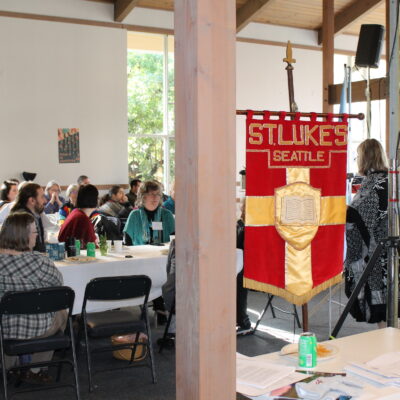by the Rev. Robert C. Laird
Growing up in Minnesota, I was involved as a musician in a youth program called Teens Encounter Christ, which is modeled on Cursillo.
On these weekends, I often heard the spiritual director of the weekend, a priest named Fr. Jim, tell the story of his Clinical Pastoral Education (CPE) experience while he was in seminary.
He story was one of regret; he remembered talking with a teenager, who had just lost a family member. The teenager said to Fr. Jim, who had sat with the family while their beloved died, “Man, your job must really suck.”
Fr. Jim had no response; in that moment, he muttered something, and he always regretted not saying something more eloquent.
When a moment came in which Fr. Jim could proclaim the resurrection, Christ’s triumph over death; when he could have said, “Actually, no, my job doesn’t suck, because I believe in Christ, both crucified and risen; I believe in the resurrection of the body, and the life everlasting. If it weren’t for that, then yes, it would definitely suck.”
Fr. Jim lives with that regret to this day (though I should say that by this point, considering the mileage he’s gotten out of the story, it’s probably best that he was a little flat-footed that day).
Peter has a moment kind of like that today.
Jesus has been sought by the crowds incessantly; the crowds find Jesus, and he does amazing things; then Jesus tries to get away from the crowds, so he can spend some time in prayer, and they find him again, and again, the crowds inundate him.
Jesus is once again trying to get away, and he sends the disciples across the Sea of Galilee, to go on to the other side.
The Sea of Galilee is 13 miles long, and 8 miles wide; its average depth is 84 feet;
it’s not so big that you can’t see across it, but it’s nothing to trifle with, either; when Matthew’s Gospel says the wind was against them, a long way out into the sea, and they were being battered by the waves, that’s not good for them.
Remember, many of the Disciples are fishermen:
they know boats,
they know weather,
and they know how bad the situation they’re in is.
Sailing to the other side of the sea like Jesus instructed them to will take everything the Disciples have, if they don’t all drown in the process.
Jesus first spends time in prayer, (Jesus always prays first) then early in the morning,
as daylight approaches, Jesus walks on the water to meet the Disciples, struggling in their boat, miles from shore in the Sea of Galilee.
And quite understandably, the Disciples are terrified; people can’t walk on water,
so they think at first that he must be a ghost; how could this possibly be Jesus?
And not only is Jesus’ divinity proclaimed in his action, walking on the water, but he then says, “It is I.” What’s so interesting about Jesus’ response is that in the Greek version of the Old Testament, the Septuagint, Jesus says the same words to the Disciples in their boat that God says to the Moses at the Burning Bush: “It is I,” that is, I AM is here.
This is an amazing statement from Jesus: He is tying himself directly to God, making a statement to his disciples about who he is: Not only Jesus, but Christ, the Messiah, God’s agent.
Jesus tells them that he is there, and that God is with him, both by this sign, walking to them in their boat, and through his proclamation, connecting himself back to God from God’s first words to Moses.
But Peter, who is always willing to make himself look silly so that Jesus can drive home a point, looks to test Jesus, invites Jesus to prove that he is divine: asking, Let me join you.
And Peter is invited out onto the waves, but his gambit fails; Peter doesn’t have the faith he needs, and he begins to sink into the waters.
And here’s the amazing part: even though Peter tested Jesus, even though Peter was the one who foolishly asked to be out there on the water, Jesus reaches out his hand, and catches Peter, and they step into the boat.
Not only do they step into the boat, but then the wind stops, too; and everyone in the boat that morning sees Jesus more clearly, more fully, and they worship him.
Jesus walking on the water is certainly an iconic image from the Gospel stories; it’s the stuff Hollywood dreams of. But the walking on the water itself is almost incidental to the actual point of the story.
They are terrified when they first see Jesus, assuming he must be a ghost, but then they realize it’s him, and they see him give Peter the opportunity to show his faith, which Peter fails to do.
And Jesus saves him from his failure.
Peter asks to test Jesus, this guy who is walking on water, and Jesus says, sure, come out and join me.
And so Peter, the rock upon which the church will be founded, takes the first step, and the second step, and finds himself out on the water with Jesus, at which time he promptly falters, and panics, and begins to sink.
And Jesus is right there to save him, to help him back into the boat.
And it’s so easy to see the world through Peter’s eyes, to identify with Peter in this failed field trip.
Jesus is inviting us all to come out on the water, to join him there, standing in faith with Jesus, in the middle of a storm raging all around us, and so we take that step with Peter,
and we panic with Peter, and we are saved by Jesus like Peter, despite our trembling faith, which may not be enough to push us forward.
That’s the tough part of being called to be a disciple: we’re not usually called to be disciples at brunch with the family, or on the sofa with a bowl of popcorn (though we are called to be disciples then, too).
We’re called to be disciples in the storms, called out of the boat, onto the water with Jesus, where, as Peter found out, we need a strong faith to sustain us,
so we don’t begin to sink into the water, like Peter did.
Ernest T. Campbell, the senior pastor of the Riverside Church in New York from 1968-1976, once claimed at a conference on the crisis of our churches that “the reason we seem to lack faith in our time is that we are not doing anything that requires it.”
Discipleship, following Jesus as Lord, and working to make the Reign of God known and felt, in our world today, is hard work, and it requires faith and nerve.
We aren’t going to get it right all the time; in fact, we’ll get it wrong more often than not.
Remember: Peter, the rock upon which the church was founded, failed when he was asked to join Jesus; it’s going to happen to us, too.
But Jesus did found the church on Peter the Rock;
and that church continues today,
and is thriving,
and the Gospel is being spread across the world,
and has found each of you, sitting here today,
and can change your life so completely
that you can join Jesus out on the water.
And just like Peter, when your faith isn’t enough, Jesus is there to reach out,
and catch you, and help you back into the boat.
The truly Good News of the Gospel today is that Jesus is there to catch us, to help us when our faith isn’t strong enough, to hold our hands when we panic, to help us back into the boat.
Not only has Jesus set a calling before us that is truly difficult: spread the Gospel,
tell the Good News, join me on the water; but Jesus has also assured us that when we aren’t strong enough, he can be strong enough for us, and will catch us when we fall down.
My friend Fr. Jim, who didn’t have the answer he needed that day in the hospital,
was out on the water with Jesus, sitting with a family that was wrapped in grief, and he didn’t have the answer he needed at the minute he wanted it.
But he claimed that story, and he kept telling it, kept telling others about how he would answer that question differently, if he was given the chance.
Fr. Jim didn’t tell one teenager that his job was easy, because Jesus had done the hard work already.
Instead, Jesus gave Fr. Jim his hand, and Fr. Jim has told hundreds of teenagers
the story of Jesus’ redemption of the world, and the love of God.
Jesus can make some amazing lemonade out of the lemons in our lives. He calls us out onto the water with him, and, if we begin to sink, he can even redeem that.
We only need to take the first step,
out of the boat,
and into a life of faith.






